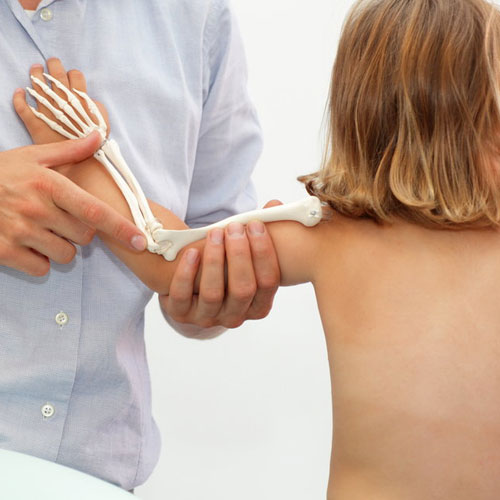Exploring Pediatric Orthopedics: Ensuring Healthy Bones and Joints in Children
Pediatric orthopedics is a specialized branch of medicine dedicated to the care of children’s musculoskeletal system. This field plays a pivotal role in ensuring that children grow up with strong, healthy bones and joints. In this comprehensive guide, we will delve into the world of pediatric orthopedics, exploring its significance and shedding light on common conditions that affect children’s musculoskeletal health.

Signs and Symptoms: Recognizing Pediatric Orthopedic Issues
Early detection of pediatric orthopedic issues is crucial for effective treatment and prevention of long-term complications. Parents and caregivers can play a pivotal role in identifying signs and symptoms that may indicate underlying orthopedic problems in children.
Common Pediatric Orthopedic Conditions
Understanding the most prevalent pediatric orthopedic conditions is crucial for recognizing potential issues in children. Here are some common conditions:
Developmental Dysplasia of the Hip (DDH)
Developmental dysplasia of the hip is a condition where the hip joint doesn’t develop correctly. It’s often present at birth and can lead to hip joint instability and potential long-term hip problems.
Scoliosis and Spine Disorders
Scoliosis is an abnormal curvature of the spine, which can affect a child’s posture and overall spinal health. Other spine disorders may include kyphosis and lordosis.
Clubfoot (Talipes Equinovarus)
Clubfoot is a congenital condition where a baby’s foot is twisted or positioned abnormally. Early treatment is crucial for correcting clubfoot.
Diagnostic Approaches: Assessing Pediatric Orthopedic Problems
When signs and symptoms of pediatric orthopedic issues arise, a thorough diagnostic approach is essential. Pediatric orthopedic specialists employ various methods to identify and evaluate these problems:
Physical Examinations
Pediatric orthopedic physicians conduct comprehensive physical examinations to assess a child’s musculoskeletal health. This may include observing posture, gait, and joint mobility.
Imaging Techniques (X-rays, MRI, Ultrasound)
Diagnostic imaging plays a crucial role in assessing bone and joint health. X-rays, MRI scans, and ultrasounds are commonly used to visualize orthopedic conditions.
Laboratory Tests
In some cases, blood tests and other laboratory assessments may be necessary to rule out underlying medical conditions.
Collaborative Care
Pediatric orthopedic care often involves collaboration among different healthcare professionals. These may include:
Pediatric Orthopedic Specialists
Pediatric orthopedic surgeons are highly trained in treating musculoskeletal issues in children. They provide surgical interventions when necessary and work closely with other specialists to ensure comprehensive care.
Physical Therapists
Physical therapists specialize in helping children improve their strength, mobility, and function through exercises and therapies tailored to their specific orthopedic needs.
Occupational Therapists
Occupational therapists assist children in developing essential daily living skills, especially when orthopedic conditions affect their abilities.
Prevention Strategies: Promoting Musculoskeletal Health in Children
Preventing pediatric orthopedic issues is a priority for parents and caregivers. Here are some prevention strategies:
Ensure a Balanced Diet
Proper nutrition supports healthy bone and muscle development. Ensure children have a well-balanced diet rich in calcium and vitamin D.
Encourage Physical Activity
Regular physical activity helps strengthen muscles and bones. Encourage children to engage in age-appropriate exercises and activities.
Safety Measures
Take precautions to prevent accidents and injuries, such as using safety gear when participating in sports or outdoor activities.
Early Intervention
If you notice any signs or symptoms of orthopedic issues in your child, seek medical attention promptly. Early intervention often leads to better outcomes.
FAQ About Pediatric Orthopedics
What is pediatric orthopedics?
Pediatric orthopedics is a specialized branch of medicine focused on diagnosing, treating, and preventing musculoskeletal issues in children.
When should I consult a pediatric orthopedic specialist?
You should consult a pediatric orthopedic specialist if your child experiences persistent musculoskeletal pain, deformities, difficulty moving, or if you notice any irregularities in their bone or joint development.
What are common pediatric orthopedic conditions?
Common conditions include developmental dysplasia of the hip (DDH), scoliosis, clubfoot, growth plate injuries, fractures, and cerebral palsy-related orthopedic issues, among others.
How are pediatric orthopedic issues diagnosed?
Diagnosis involves physical examinations, imaging techniques (X-rays, MRI, ultrasound), laboratory tests, and consultations with pediatric orthopedic specialists.
Can pediatric orthopedic conditions be treated without surgery?
Yes, many conditions can be managed non-surgically through methods like bracing, physical therapy, medications, and casting.
When is surgery necessary for pediatric orthopedic conditions?
Surgery is considered when non-surgical interventions are insufficient. It may be required for conditions like severe scoliosis, hip dysplasia, clubfoot, and fractures.
How do pediatric orthopedic specialists collaborate with other healthcare professionals?
They work with physical therapists, occupational therapists, pediatricians, and other specialists to provide comprehensive care tailored to the child’s needs.
What can parents do to promote musculoskeletal health in children?
Parents can ensure a balanced diet rich in calcium and vitamin D, encourage physical activity, promote safety measures, and seek early intervention if they notice any orthopedic issues.
Are pediatric orthopedic conditions preventable?
While not all conditions are preventable, early detection and intervention can often minimize the impact of musculoskeletal issues.
How often should my child see a pediatric orthopedic specialist?
The frequency of visits depends on the specific condition and treatment plan. Regular follow-up appointments are essential for ongoing monitoring and adjustments to the treatment plan.
Conclusion:
Pediatric orthopedics plays a vital role in ensuring that children grow up with strong, healthy bones and joints. By recognizing early signs, seeking prompt medical attention, and collaborating with pediatric orthopedic specialists, parents, and caregivers can provide children with the best possible musculoskeletal care.




